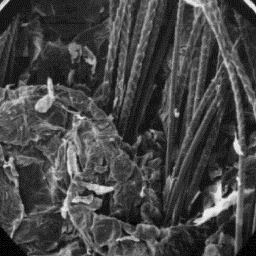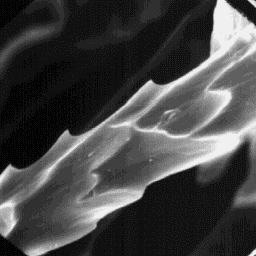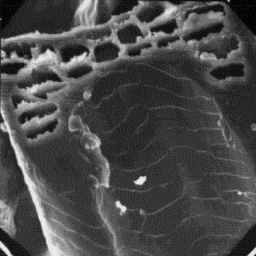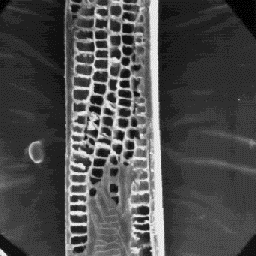 Oryctolagus cuniculus
Oryctolagus cuniculus
---------------------
English: Rabbit
German: Kaninchen
French: Lapin
Spanish: Conejo
Distribution areas
------------------
Thecrabbit originates from South-West
Europe, from where it spread throughout
Europe. After being introduced to Australia
and New Zealand, they bred in these
countries in large numbers. Rabbits were
domesticated in the Middle Ages cnd, today,
they are the most common domestic animals. The cuticular structure
A number of varieties of domesticated of the fine fibres, 1000x
rabbits are found in all the continents;
these differ in the length of the hair and in the body size and shape.
Description of the fur
----------------------
The skins are from 30 to 55 cm long. The fur coat of the wild rabbit is
grey or yellow-grey in colour. The sides are red-grey and the belly together
with the inside of the legs, is white in colour.
|
|
 Oryctolagus cuniculus
Oryctolagus cuniculus
---------------------
English: Rabbit
German: Kaninchen
French: Lapin
Spanish: Conejo
Structure of the hair
---------------------
Structure of the skin surface is furrowed
and the hair follicles are narrow with
raised edges. On average, the follicles
contain clusters of 5 to 16 hairs. The
length of the fine undercoat fibres is 20 to
30 mm; the coarse guard hairs are up to 35
or even 50 mm long. The surface structure
of the skin, 200x
The fine fur fibres are circular and, in
the upper parts of the shaft, ellipsoidal in cross-section with a diameter of
8 to 20 µm. The cuticular scales are cornet-like at the bottom,craised
edge-shaped in the middle and chevron-like in the upper parts of the hair
shaft. The scale surface is smooth and the scale margins are straight. The
medulla is unbroken, wide and central symmetrical-shaped in cross-scction.
The overall structure of the medulla belongs to the uniserial ladder type
with a granular infilling substance.
|
|
 Oryctolagus cuniculus
Oryctolagus cuniculus
---------------------
English: Rabbit
German: Kaninchen
French: Lapin
Spanish: Conejo
The intermediate fibres have a diameter
of 20 to 30 µm. The cross-section is
ellipsoidal and, in the upper parts of the
shaft, dumb-bell-shaped in outline. The
cuticular scales are of the raised
edge-shaped type; in the upper parts of the
shaft, the chevron-like type is also found.
The cuticular surface is smooth and the
scale margins are straight. The fibres have The cuticular structure
a wide, unbroken medulla and are central of the fine fibres, 2000x
symmetrical-shaped in cross-section. The
overall structure belongs to the uniserial ladder type, but is often the
multiserial ladder type in the upper parts of the shaft, with a sheet-like
infilling material.
The guard hairs have a circular cross-section, except in the upper parts
where it is usually dumb-bell-shaped, with a diameter of 30 to 75 µm. The
cuticular scales are even tile-like with smooth surfaces and straight scale
margins.
|
|
 Oryctolagus cuniculus
Oryctolagus cuniculus
---------------------
English: Rabbit
German: Kaninchen
French: Lapin
Spanish: Conejo
The medullar column is wide, unbroken and
central symmetrical-shaped in cross-section.
The overall structure belongs to the
multiserial ladder type with a sheet-like or
granular medullar infilling substance.
Transverse section
of a guard hair, 1000x
|
|
 Oryctolagus cuniculus
Oryctolagus cuniculus
---------------------
English: Rabbit
German: Kaninchen
French: Lapin
Spanish: Conejo
Longitudinal section
of a guard hair, 400x
Numerical code for rabbit skin surface
--------------------------------------
Surface of the skin: 1-5-3
Fine fur fibres: 2.1-5.9-1-1-2-1-1-1-6-8.21-12.35
Intermediate fibres: 2.8-9.8-1-1-2-1-1-1.4-1-20.31-25.41
Guard hairs: 2.8-2-3-1-2-1-1-4-1.6-30.75-30.51
|




